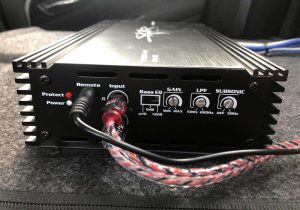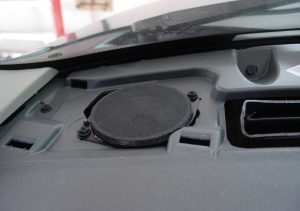If you’ve ever experienced a sudden drop in sound quality or noticed your car amplifier overheating more frequently, you might be dealing with a common issue: your car amp not getting enough voltage. As a fellow car audio enthusiast who has faced the same problem, I understand the frustration. In this guide, I’ll share my personal experience and provide a comprehensive solution to ensure your car amplifier receives the voltage it needs for optimal performance.
Contents
- Understanding the Basics of Car Amplifiers
- Signs of Insufficient Voltage to Your Car Amp
- Common Causes of Low Voltage to Car Amplifiers
- Steps to Diagnose the Issue
- How Many Volts Should My Amp Be Getting?
- Solutions to Ensure Your Car Amp Gets Adequate Voltage
- What Happens If My Amp Is Not Powerful Enough?
- Personal Experience: Overcoming the “Amp Not Getting Enough Voltage” Challenge
- Conclusion
- FAQs
Understanding the Basics of Car Amplifiers
Car amplifiers are the backbone of a superior audio experience in your car. These devices require a consistent and adequate supply of voltage to operate at their best. When the voltage falls below the required levels, it can result in a cascade of issues that affect the overall audio quality in your car.
Signs of Insufficient Voltage to Your Car Amp
Diminished Sound Quality: A perceptible drop in audio clarity and power serves as an early warning sign of a potential voltage supply problem.
Amplifier Overheating: If your amplifier feels unusually hot during operation, it might be a clear indication of insufficient voltage, forcing the amplifier to work harder than necessary.
Frequent Blowing of Fuses: Insufficient voltage can lead to increased current draw, causing fuses to blow more frequently as the amplifier tries to compensate for the deficit.
Inconsistent Power Supply: Unstable voltage may result in sporadic power supply to the amplifier, leading to interruptions in your audio playback.
Common Causes of Low Voltage to Car Amplifiers
Insufficient Power from the Car Battery: Aging or damaged batteries may struggle to provide the necessary power for your amplifier.
Incorrect Battery Size: Using a battery that does not meet the amplifier’s power requirements can contribute to voltage-related issues.
Poor Ground Connections: Corroded or loose ground wires impede the efficient flow of current, while inadequate grounding locations can compromise voltage stability.
Steps to Diagnose the Issue
Voltage Measurement at the Battery Terminals: Use a multimeter to measure the voltage at the car battery terminals, providing a baseline for diagnosing potential issues.
Checking Power and Ground Connections: Thoroughly inspect the amplifier’s power and ground connections for any signs of loose or damaged wires.
Verifying Power Requirements: Ensure that the amplifier’s power requirements align with the capabilities of the car battery.
Inspecting Ground Connections: Clean and secure ground wires to improve conductivity, and explore alternative grounding locations for enhanced stability.
How Many Volts Should My Amp Be Getting?
The voltage requirements for your car amplifier depend on its design and power specifications. In general, car amplifiers operate within a range of 11 to 14.4 volts, reflecting the typical voltage output of a vehicle’s electrical system when the engine is running. However, this can vary based on the specific amplifier model and its compatibility with your car’s electrical setup.
To determine the ideal voltage for your amp, refer to the manufacturer’s specifications provided in the user manual or product documentation. Exceeding or falling below these voltage recommendations can adversely affect the amplifier’s performance, leading to issues like distorted sound, overheating, or even damage. Regularly monitor your vehicle’s electrical system and ensure it meets the amplifier’s requirements to maintain optimal functionality and prevent potential damage.
Solutions to Ensure Your Car Amp Gets Adequate Voltage
Upgrading the Car Battery: Opt for a high-performance battery that not only meets but exceeds the power demands of your amplifier.
Improving Ground Connections: Ensure ground wires are clean and securely connected, considering alternative grounding locations for added stability.
Additional Measures for Voltage Stability: Install a voltage stabilizer to regulate and stabilize the voltage supply to your amplifier. Additionally, consider upgrading power and ground cables for efficient current flow.
What Happens If My Amp Is Not Powerful Enough?
If your amplifier lacks sufficient power for your car audio system, several issues can arise, significantly impacting your audio experience.
1. Distorted Sound Quality: A weak or underpowered amplifier struggles to produce clear, distortion-free audio. This results in a muddied sound that lacks the crispness and detail intended by the music or audio source.
2. Inadequate Volume Levels: Insufficient power limits the amplifier’s ability to drive your speakers, leading to reduced volume levels. This can be particularly problematic in noisy environments or when attempting to fill a large vehicle interior with sound.
3. Risk of Speaker Damage: When an amplifier is underpowered, users may be tempted to turn up the volume to compensate. This can push the speakers beyond their capacity, causing distortion and potentially damaging the speakers over time.
4. Limited Dynamic Range: A lack of power restricts the dynamic range, preventing the amplifier from effectively reproducing both soft and loud passages in music. This results in a flattened, less expressive sound.
To avoid these issues, it’s crucial to match your amplifier’s power output to the requirements of your speakers, ensuring a harmonious and high-quality audio experience.
Personal Experience: Overcoming the “Amp Not Getting Enough Voltage” Challenge
Having personally encountered and successfully resolved voltage issues, I found that upgrading to a high-performance battery and meticulously cleaning and securing ground connections significantly improved my amplifier’s performance. The result was not just a restoration of audio quality but also the elimination of overheating problems. It’s crucial to remain diligent in maintaining your car audio system to ensure consistent, top-notch performance.
Conclusion
In conclusion, troubleshooting and resolving voltage issues in your car amplifier demand a systematic approach. Regular maintenance, including upgrading the battery and ensuring secure ground connections, goes a long way in optimizing your audio experience. By following the steps outlined in this guide, you can enjoy uninterrupted and high-quality sound from your car stereo system. Don’t hesitate to share your experiences and, if needed, seek professional help for a more tailored solution. Your journey towards an enhanced car audio experience starts with addressing the root cause of insufficient voltage to your amplifier.
FAQs
1. What Causes an Amp to Overheat?
Amplifiers can overheat due to factors such as insufficient voltage, inadequate ventilation, or pushing the amplifier beyond its power limits. Ensure proper power supply, adequate cooling, and avoid overdriving the amplifier to prevent overheating.
2. Can I Use a Higher Voltage Battery for My Car Amp?
It’s crucial to use a battery that aligns with the amplifier’s voltage specifications. Using a higher voltage battery than recommended can damage the amplifier and other components in the audio system.
3. How Do I Choose the Right Battery for My Car Amp?
Select a battery with sufficient capacity (Ah) and cold-cranking amps (CCA) to meet the amplifier’s power demands. Consult the amplifier’s manual or manufacturer for specific battery recommendations.
4. What’s the Importance of Grounding in Solving Voltage Issues?
Proper grounding ensures efficient current flow and stability. Clean and secure ground connections prevent voltage drops, enhancing the overall performance of your car amplifier.
5. Can I Install a Voltage Stabilizer to Solve Voltage Problems?
Yes, a voltage stabilizer can help regulate and stabilize the voltage supply to your amplifier, preventing fluctuations and enhancing audio performance. Ensure compatibility and follow the manufacturer’s recommendations during installation.
6. How Often Should I Check My Car Amp’s Voltage?
Regularly monitor your car amp’s voltage, especially when experiencing audio issues. Periodic checks, such as during routine maintenance, can help identify and address voltage-related issues promptly.






